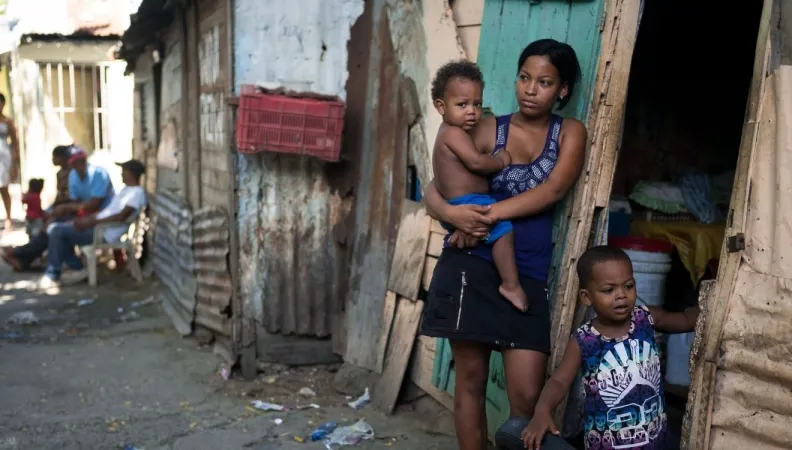Share the page
Tackling the Twin Challenges of Climate Change and Gender Inequality
Published on

They are two of the battles that have come to define our times. What is less well known about climate change and gender inequality though, is just how intertwined they are. From employment to property-ownership and overall decision-making, men and women do not enjoy the same rights. But as climate change raises the stakes of inequalities, it is also driving the search for solutions.
Women and girls bear a disproportionate burden in the fallout from climate change. Invariably responsible for things like household water supply, heating and cooking, their work is made more difficult when drought strikes or rainfall diminishes, as highlighted in a growing number of United Nations publications.
When climate change increases gender injustice
In the Caribbean, extreme temperatures, rising sea levels and a loss of biodiversity have differentiated impacts, as noted in the Inter-American Development Bank’s 2020 Study of the impacts of climate change on women and men in the Caribbean.
Droughts are becoming more and more regular and have repercussions on fishing practices, agriculture and market gardening. With constant temperature change reducing agro-biodiversity and traditional medicine options, women and girls often have to compensate.
“Additional workloads can be a direct consequence of climate change for women, making their days much longer”, says Leisa Perch, International Gender and Environment Consultant currently working in the Caribbean for UN Women. “The increasing scarcity of water resources, which disrupts daily routines, can threaten livelihoods and income-generating activities. Prolonged physical and economic displacement, as well as insecurity, can also put women at risk from domestic and gender-based violence.”
Resilience can emerge, in spite of differences
Inequalities are visible in the increasingly intense extreme weather events hitting the region, linked to rising sea levels in the sub-region and causing environmental migration. In the aftermath of Hurricane Dorian in the Bahamas in 2019, 70% of those displaced from the region of Grand Bahama to New Providence were women, even though they represented only 51.5% of the population. After the hurricane, women were more likely to have limited access to the resources and skills needed to rebuild homes.
Hence the need to reinforce women’s skills and coping abilities to deal with the growing challenges posed by climate change. In the Caribbean, women have less access to land. In Haiti, 74.7% of male farmers own land compared to only 25.3% of women. In Saint Lucia, the figures are 70.3% and 29.7% respectively. This means women are less equipped to move from subsistence farming to commercial or industrial agriculture. Similar trends can be observed in fishing, where women tend to work at the lower end of the value chain, in processing.
However, because women are central actors in food production, they possess the knowledge and skills to contribute to climate change adaptation and mitigation. “The empowerment of women has direct impacts on their own health, the education of children and household food security,” says Leisa Perch, “as well as their livelihood and income-generating opportunities, thus increasing the resilience of individuals and households to future climate shocks.”
Strengthening the link between gender and climate in development aid
Agence Française de Développement is funding several projects to tackle both gender inequality and climate change.
In the Dominican Republic, the Sierra Plan received a €20 million loan and a €1.6 M grant from AFD for the third phase of the project. This funding has allowed for an assessment of women’s participation in territorial management and activities promoting the socio-economic development of the region.
"Women are already the most aware of and alive to environmental issues,” says Inmaculada Adames, executive vice-president of the Sierra Plan. “They participate in large numbers in environmental protection initiatives through river cleaning or recycling projects. They are present in environmental protection committees, and in schools whose programs aim to promote sustainable territorial development."
AFD has also set up Adapt'Action, a tool with a budget of €30 M over four years (2017-2021), to support countries as they fulfill their commitment to more resilient development. Adapt'Action supports the Commission of the Organization of Eastern Caribbean States and its twelve associate member states in addressing nature-based solutions and gender mainstreaming.
In Cuba, the evaluation of climate risks and adaptation measures for resilient development in the city of Cienfuegos includes a gender analysis and action plan.
In the Dominican Republic, the feasibility study for an adaptive social protection program at a watershed includes a gender-sensitive socio-anthropological profile of the territory.
In this way, AFD is emerging from an era in which development projects have for too long been “gender blind." It's part of an effort to embrace a gender equality approach that is inclusive, and which in the end, will create bigger benefits for an even greater number.
